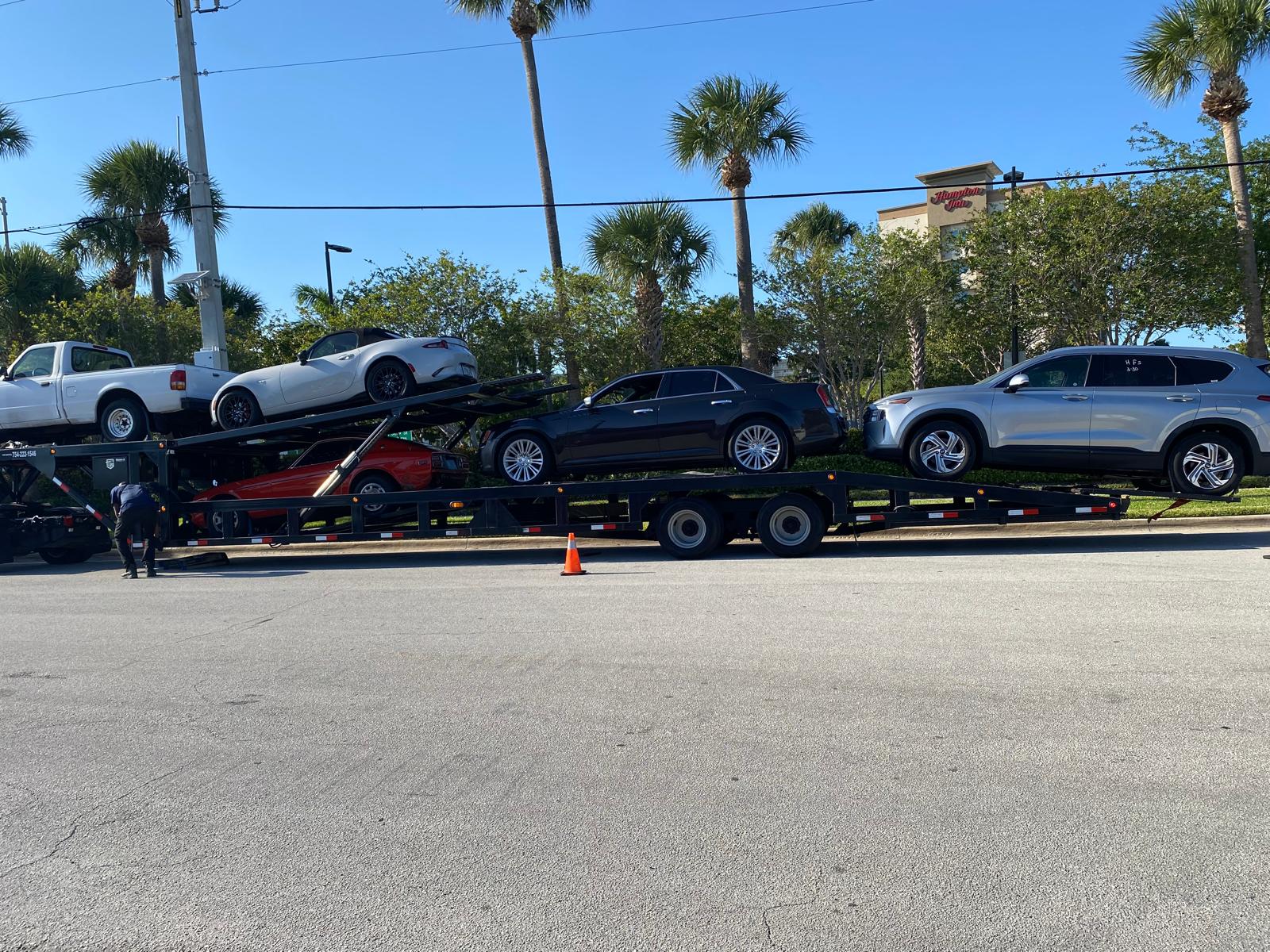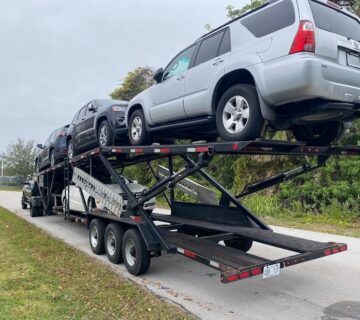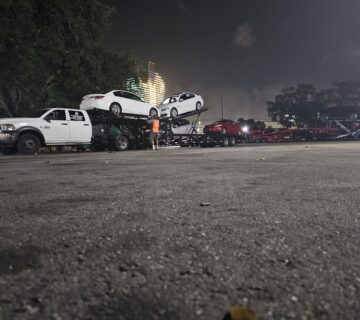
Your Essential Cross-State Car Shipping Checklist: Plan Your Move with Mission Auto Transport
Estimated reading time: 15 minutes
Key Takeaways
-
- A comprehensive checklist is essential for avoiding common pitfalls in cross-state vehicle shipping
-
- Research and select only licensed, reputable auto transport companies with proper credentials
-
- Use Mission Auto Transport’s free quote tool to accurately budget your shipping costs
-
- Properly prepare your vehicle by cleaning, documenting condition, and addressing mechanical needs
-
- Choose between open and enclosed transport based on your vehicle’s value and protection needs
- Document your vehicle’s condition at both pickup and delivery to ensure proper protection
Table of Contents
Introduction
Moving a vehicle from one state to another involves numerous complexities and potential challenges that can catch unprepared car owners off guard. Whether you’re relocating for a new job, sending a vehicle to a college-bound student, or purchasing a car from out of state, cross-state car shipping requires meticulous planning to ensure everything goes smoothly. This is precisely where a comprehensive cross-state car shipping checklist becomes invaluable. Having a detailed plan in place helps guarantee the safety of your vehicle, ensures cost-efficiency throughout the process, and provides much-needed peace of mind during what can otherwise be a stressful experience.
Mission Auto Transport stands as a trusted partner in this journey, with over 22 years of industry experience helping vehicle owners navigate the intricacies of auto shipping. Their decades of expertise have allowed them to refine their processes, anticipate common issues, and develop solutions that make cross-state vehicle transport as seamless as possible. One particularly valuable tool they offer is their free quote system, which allows you to begin your budget planning process with accurate information tailored to your specific shipping needs. As we explore the essential elements of a cross-state car shipping checklist, we’ll highlight how Mission Auto Transport’s services align with best practices in the industry.
Why a Checklist is Critical for Cross-State Car Shipping
A cross-state car shipping checklist serves as more than just a to-do list—it’s a comprehensive roadmap that helps you navigate the potentially complex journey of transporting your vehicle across state lines. This systematic approach to planning helps you avoid the most common pitfalls associated with vehicle shipping, including unexpected damage, frustrating delays, and hidden costs that can quickly derail your budget. By following a well-structured checklist, you create a framework that ensures nothing important falls through the cracks.
One of the primary benefits of utilizing a detailed checklist is ensuring compliance with varying state regulations. Different states may have specific requirements regarding vehicle transportation, documentation, and insurance coverage. Without proper planning, you might find yourself facing legal complications or delays at state borders. Additionally, a thorough checklist guides you through proper vehicle preparation, which is essential for preventing damage during transit. From securing loose components to documenting pre-existing conditions, these preparatory steps can save you significant headaches down the road. Perhaps most importantly, a well-designed checklist emphasizes the importance of accurate cost estimation. This is where Mission Auto Transport’s free quote tool becomes particularly valuable, allowing you to understand the financial commitment involved before making any binding decisions. By obtaining a detailed quote early in the process, you can budget accordingly and avoid financial surprises that might otherwise emerge throughout the shipping process. The peace of mind that comes from knowing you’ve properly planned each aspect of your vehicle’s journey is invaluable.
Step 1: Research Licensed Transport Companies
When preparing to ship your vehicle across state lines, your first and most crucial step is thoroughly researching and selecting a reputable auto transport company. The market is filled with options ranging from established industry leaders to fly-by-night operations, making careful evaluation essential. Begin by verifying that any transport company you consider holds valid USDOT and FMCSA licensing. These credentials indicate that the company meets federal safety standards and operates legally within the transportation industry. Beyond basic licensing, examine each company’s insurance coverage details, as this protection will be your financial safeguard should anything unexpected occur during transit.
Mission Auto Transport distinguishes itself in this crowded marketplace with its impressive 22-year track record of reliable service and commitment to customer satisfaction. Their A+ Better Business Bureau rating reflects a consistent history of resolving customer concerns and maintaining high service standards throughout their two decades in business. This kind of established reputation is invaluable when entrusting someone with transporting your vehicle across state lines. Industry experts generally recommend comparing at least three to five companies before making your final decision. This comparison should go beyond just price—evaluate each company’s experience with your specific route, their communication practices, and the transparency of their policies. Take time to read customer reviews across multiple platforms to identify patterns in service quality. Remember that the lowest quote doesn’t always represent the best value, especially when it comes to protecting a significant investment like your vehicle. By conducting thorough research at this stage, you establish a foundation for a successful shipping experience.
Step 2: Use Mission Auto Transport’s Free Quote Tool
Securing an accurate cost estimate stands as one of the most crucial early steps in planning your vehicle’s cross-state journey. Mission Auto Transport makes this process straightforward through their user-friendly free quote tool available on their website. The process begins by simply navigating to the quote section, where you’ll enter basic details about your shipment, including pickup and delivery locations, vehicle specifications, and your preferred timeframe. Within moments, you’ll receive a comprehensive estimate tailored to your specific shipping needs, allowing you to begin planning your budget with confidence.
Understanding how these quotes are calculated helps you make informed decisions about your shipping options. The distance between your origin and destination points naturally plays a significant role in determining costs, with cross-state routes priced differently than local moves based on fuel consumption, driver hours, and highway tolls involved. Vehicle type represents another major factor, as sedans, SUVs, trucks, and luxury vehicles each require different handling considerations and space allocation on transport carriers. Additionally, your chosen service tier significantly impacts pricing, with open transport offering cost-effective solutions for standard vehicles, while enclosed transport provides premium protection for high-value, classic, or luxury automobiles at a corresponding price point. Seasonal factors may also influence your quote, as demand fluctuates throughout the year, particularly along popular relocation routes. The importance of securing quotes early in your planning process cannot be overstated. By obtaining this information weeks or even months before your intended shipping date, you gain valuable flexibility to adjust your budget, explore different service options, or potentially schedule during lower-demand periods to optimize costs. This proactive approach to financial planning represents a cornerstone of a successful vehicle shipping experience.
Step 3: Prepare Your Vehicle for Transit
Proper preparation of your vehicle before handing it over to the transport company is essential for ensuring a smooth shipping experience. Begin with a thorough cleaning of both the interior and exterior of your car. This step serves a practical purpose beyond aesthetics – a clean vehicle allows for more accurate documentation of its pre-shipping condition. Take detailed photographs of your vehicle from multiple angles, focusing particularly on any existing scratches, dents, or other imperfections. These images will serve as crucial evidence should any disputes arise regarding the condition of your vehicle upon delivery.
The removal of personal items from your vehicle is not merely a suggestion but a requirement for most carriers. Transport insurance typically doesn’t cover personal belongings left in vehicles, and additional weight can affect shipping costs. Furthermore, items shifting during transit can potentially cause interior damage. Beyond emptying your vehicle, you should also attend to its mechanical readiness for shipping. Check all fluid levels, including oil, transmission fluid, coolant, and brake fluid, topping off as needed. Verify that your tires are properly inflated and in good condition, as proper tire pressure ensures stability during loading and unloading procedures. Address any engine lights or mechanical issues before shipping – while the vehicle won’t be driven extensively, it must be operational for loading and unloading purposes. One often overlooked aspect of vehicle preparation concerns fuel levels. Industry best practice recommends leaving your gas tank at approximately one-quarter full. This provides sufficient fuel for the necessary movement during loading and unloading while minimizing the additional weight that could impact shipping costs. Additionally, inspect your vehicle for leaks and address any issues before shipping, as carriers may refuse to transport vehicles with active fluid leaks due to environmental and safety concerns. Following this comprehensive preparation checklist significantly reduces the likelihood of complications during the shipping process.
Step 4: Select a Shipping Method
Choosing the appropriate shipping method for your cross-state vehicle transport represents a critical decision that balances protection, cost, and specific vehicle needs. The two primary options available to most consumers are open transport and enclosed transport, each with distinct advantages depending on your situation. Open transport, the most commonly selected option, involves shipping your vehicle on an open-air carrier alongside several other vehicles. This method has become the industry standard for good reason – it offers reliable service at the most economical price point. The cost efficiency stems from the carrier’s ability to transport multiple vehicles simultaneously, spreading operational expenses across several customers. Open transport is particularly well-suited for standard daily drivers, including sedans, SUVs, and trucks that don’t require specialized handling or extreme protection from the elements.
For owners of luxury, classic, exotic, or otherwise high-value vehicles, enclosed transport provides a premium alternative worth serious consideration. These specialized carriers completely shield your vehicle from road debris, weather elements, and public view throughout the journey. The enclosed environment offers superior protection against potential cosmetic damage from rocks, dust, and inclement weather that might otherwise affect vehicles during long-distance transport. While this enhanced protection comes at a price premium – typically 30-50% higher than open transport – many owners of valuable vehicles consider it an essential investment in preserving their automobile’s condition and value. Mission Auto Transport excels in providing both shipping options, complemented by their advanced real-time tracking capabilities that allow you to monitor your vehicle’s progress throughout its journey regardless of which method you select. When determining which option best suits your needs, consider factors such as your vehicle’s value, your budget constraints, seasonal weather conditions along the transport route, and your timeline flexibility. For standard vehicles and budget-conscious shipping, open transport offers excellent value, while those shipping rare, expensive, or sentimentally valuable vehicles often find the additional investment in enclosed transport provides worthwhile peace of mind.
Step 5: Finalize Logistics with Your Transporter
Once you’ve selected your transport company and shipping method, finalizing the logistical details represents a crucial step in your cross-state car shipping checklist. This phase requires clear communication and confirmation of all critical information to prevent misunderstandings or complications during the shipping process. Begin by confirming and documenting the exact pickup and delivery addresses. Provide complete information, including any access restrictions or special instructions that might affect the driver’s ability to reach the location. For example, many large transport trucks cannot enter certain residential areas with low-hanging trees or tight turns, potentially requiring alternate pickup or drop-off points.
Establishing precise pickup and delivery dates is equally important, though some flexibility may be necessary. Most reputable transporters provide estimated time windows rather than exact appointment times due to the variables involved in long-distance transport. Ensure you understand their scheduling policies and plan accordingly, especially if you have strict timeline requirements. The documentation requirements represent another critical area requiring attention at this stage. Request clear information about the necessary paperwork, particularly focusing on insurance coverage details and Bill of Lading requirements. The Bill of Lading serves as both your receipt and the official condition report for your vehicle, making it one of the most important documents in the entire shipping process. Finally, obtain emergency contact information for both the transport company’s customer service department and, when possible, the specific driver transporting your vehicle. Having direct communication channels established before shipping begins provides valuable peace of mind and practical recourse should any issues arise during transit. Taking time to meticulously confirm these logistical details creates a solid foundation for a successful shipping experience by ensuring all parties share the same expectations and information.
Step 6: Shipping Day Protocol
When the day arrives for your vehicle to begin its cross-state journey, following a structured shipping day protocol helps ensure a smooth handoff and proper documentation of your vehicle’s condition. Plan to be present at the pickup location at the scheduled time, allowing for a window of availability since transport trucks may encounter delays due to traffic, weather, or previous pickups. When the carrier arrives, you’ll participate in perhaps the most critical element of the entire shipping process: the joint inspection with the driver. This inspection serves as the official baseline for your vehicle’s condition before transport begins.
During this inspection, both you and the driver will thoroughly examine your vehicle, noting any existing scratches, dents, or other imperfections on the Bill of Lading. Take your time with this process – be methodical and comprehensive, inspecting the entire exterior, including the roof, which is often overlooked. Document any existing damage with both written descriptions and photographs with timestamps for additional protection. The Bill of Lading will serve as your official condition report and receipt, so ensure all damage is accurately recorded before signing. As you prepare to hand over your keys, remember to disable any alarm systems that might activate during transit, as these can cause significant disruptions and potential battery drainage. Similarly, remove or deactivate toll tags and parking passes to avoid unintended charges during cross-state transport. Take final photographs or videos of your vehicle from multiple angles immediately before it’s loaded onto the transport carrier. These visual records, combined with your thorough inspection notes, provide valuable documentation should any disputes arise upon delivery. While the vast majority of shipments arrive without incident, this careful attention to documentation protects all parties by establishing a clear record of your vehicle’s pre-transport condition.
Step 7: Post-Delivery Process
When your vehicle reaches its destination, the post-delivery process represents the final crucial phase in your cross-state car shipping checklist. Just as you did at pickup, arrange to be present at the delivery location to personally receive your vehicle. Upon arrival, you’ll conduct another thorough inspection that mirrors the initial one, comparing your vehicle’s current condition against the documentation from before transport began. This inspection should be methodical and comprehensive, examining every surface of the vehicle for any new damage that might have occurred during transit. Take your time with this process – once you sign the final Bill of Lading acknowledging receipt in satisfactory condition, you may have limited recourse for addressing subsequently discovered issues.
If you identify any new damage during your inspection, immediately document it with clear photographs and ensure the driver notes these issues on the Bill of Lading before you sign. Most reputable companies, including Mission Auto Transport, have straightforward claims processes for addressing legitimate transport-related damage, but proper documentation at delivery is essential to facilitate this process. After completing the visual inspection, perform a basic functional check of your vehicle before the transport carrier departs. Start the engine to ensure it runs properly, check that all lights and signals function correctly, and verify that the vehicle shifts into gear as expected. While rare, mechanical issues can sometimes develop during transport, and identifying them immediately provides the clearest connection to the shipping process. Once you’re satisfied with both the physical condition and mechanical operation of your vehicle, sign the final delivery documents and retain copies for your records. Should any concerns arise after delivery, contact Mission Auto Transport immediately – addressing potential issues promptly typically leads to faster and more satisfactory resolutions. Following this structured post-delivery process provides proper closure to your shipping experience and ensures you’ve fulfilled your responsibilities as a diligent vehicle owner.
Conclusion
Throughout this comprehensive guide, we’ve outlined the essential elements of a cross-state car shipping checklist designed to minimize stress and eliminate unnecessary risks from the vehicle transportation process. From researching reputable transporters and obtaining accurate quotes to properly preparing your vehicle and documenting its condition, each step plays a vital role in ensuring a successful shipping experience. By following this structured approach, you transform what could be a complex and potentially frustrating process into a manageable series of well-defined tasks, each building toward the safe delivery of your vehicle to its destination.
Mission Auto Transport stands ready to partner with you throughout this journey, offering the benefit of their 22+ years of industry experience to guide your vehicle safely across state lines. Their commitment to transparent pricing, reliable service, and customer satisfaction has established them as a trusted name in the auto transport industry. As you prepare for your vehicle’s cross-state journey, consider taking the next step by requesting a free quote from Mission Auto Transport. This no-obligation estimate will provide valuable insight into the costs involved and help you begin planning your budget with confidence. Start your seamless cross-state move today with Mission Auto Transport’s expertise! Visit https://missionautotransport.com/get-your-quote/ to receive your personalized shipping estimate and take the first step toward a worry-free vehicle relocation experience.



